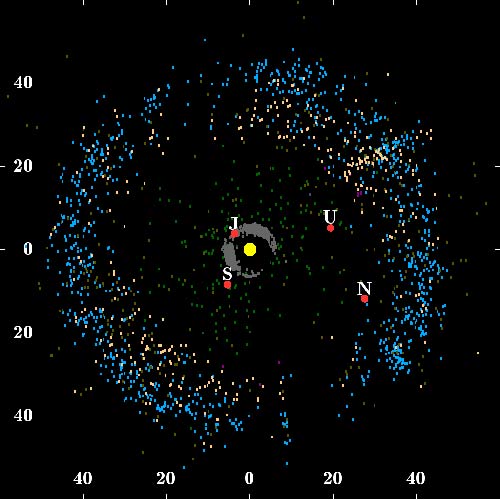centaur


Positions of known outer Solar System objects. The centaurs orbit generally inwards of the Kuiper belt and outside the Jupiter trojans. Scale in AU; epoch as of January 2015; # of objects in parenthesis.
A centaur is a minor planet whose orbit around the Sun lies typically between the orbits of Jupiter and Neptune (5 to 30 astronomical units), though it may extend inward almost as far as Mars (as in the case of Damocles, of the Damocloid family) or outward beyond Neptune (as in the case of 1995SN55, which ranges out to about 40 AU). Because centaurs cross the orbits of one or more of the giant outer planets, they are also known as outer planet crossers.
The orbits of the centaurs are dynamically unstable due to interactions with the giant planets, so they must be objects in transition from a large, outer reservoir of small bodies, believed to be the Kuiper belt, to potentially active, comet-like inner solar system objects. Known sizes range from a few tens to a few hundreds of kilometers across, though there are doubtless many smaller ones awaiting discovery. Their composition is probably intermediate between that of comets and ordinary asteroids; indeed, the first object to be called a centaur, Chiron, is now also classified as a comet following the discovery of a coma around it. In the same way that centaurs, together with trans-Neptunian objects (TNOs), may be considered to be protocomets, some comets, such as 29P/Schwassmann-Wachmann 1 and 39P/Oterma, have orbits that would allow them to be to be called centaurs.
Classification of centaurs is often difficult and there is clearly a continuum of types that includes centaurs, comets, asteroids, Kuiper belt objects, and other entities such as cubewanos and Scattered Disk objects. Were any centaur to be perturbed into an orbit that approaches the Sun, it would become a truly spectacular comet, many times brighter than any seen in historic times.
Red centaur
Red centaurs are a rare class of centaurs that appear to be covered in organic substances, giving the surface a strong reddish hue. Among them are Pholus and 1995 G0, observations of which by David Weintraub and his colleagues of Vanderbilt University, Nashville, using the 3-m infrared telescope on Mauna Kea, Hawaii, and an optical telescope at Steward Observatory, revealed that they are redder than any other asteroids in the solar system. One possibility is that the organic coating is the result of prolonged bombardment by cosmic rays which has led to the formation complex polymers rich in carbon and nitrogen.


